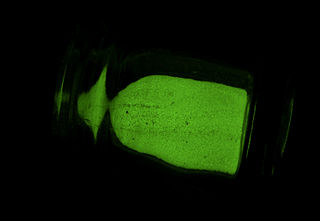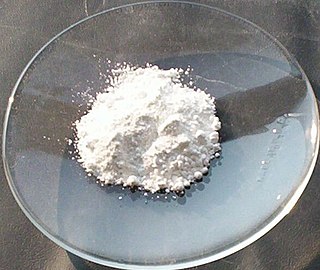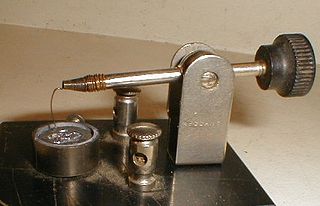Related Research Articles

Organic electronics is a field of materials science concerning the design, synthesis, characterization, and application of organic molecules or polymers that show desirable electronic properties such as conductivity. Unlike conventional inorganic conductors and semiconductors, organic electronic materials are constructed from organic (carbon-based) molecules or polymers using synthetic strategies developed in the context of organic chemistry and polymer chemistry.
A semiconductor is a material which has an electrical conductivity value falling between that of a conductor, such as copper, and an insulator, such as glass. Its resistivity falls as its temperature rises; metals behave in the opposite way. Its conducting properties may be altered in useful ways by introducing impurities ("doping") into the crystal structure. When two differently doped regions exist in the same crystal, a semiconductor junction is created. The behavior of charge carriers, which include electrons, ions, and electron holes, at these junctions is the basis of diodes, transistors, and most modern electronics. Some examples of semiconductors are silicon, germanium, gallium arsenide, and elements near the so-called "metalloid staircase" on the periodic table. After silicon, gallium arsenide is the second-most common semiconductor and is used in laser diodes, solar cells, microwave-frequency integrated circuits, and others. Silicon is a critical element for fabricating most electronic circuits.

Electroluminescence (EL) is an optical and electrical phenomenon, in which a material emits light in response to the passage of an electric current or to a strong electric field. This is distinct from black body light emission resulting from heat (incandescence), a chemical reaction (chemiluminescence), sound (sonoluminescence), or other mechanical action (mechanoluminescence).

A phosphor is a substance that exhibits the phenomenon of luminescence; it emits light when exposed to some type of radiant energy. The term is used both for fluorescent or phosphorescent substances which glow on exposure to ultraviolet or visible light, and cathodoluminescent substances which glow when struck by an electron beam in a cathode-ray tube.

An organic light-emitting diode, also known as organic electroluminescentdiode, is a light-emitting diode (LED) in which the emissive electroluminescent layer is a film of organic compound that emits light in response to an electric current. This organic layer is situated between two electrodes; typically, at least one of these electrodes is transparent. OLEDs are used to create digital displays in devices such as television screens, computer monitors, and portable systems such as smartphones and handheld game consoles. A major area of research is the development of white OLED devices for use in solid-state lighting applications.

Silicon carbide (SiC), also known as carborundum, is a hard chemical compound containing silicon and carbon. A semiconductor, it occurs in nature as the extremely rare mineral moissanite, but has been mass-produced as a powder and crystal since 1893 for use as an abrasive. Grains of silicon carbide can be bonded together by sintering to form very hard ceramics that are widely used in applications requiring high endurance, such as car brakes, car clutches and ceramic plates in bulletproof vests. Large single crystals of silicon carbide can be grown by the Lely method and they can be cut into gems known as synthetic moissanite.

A flat-panel display (FPD) is an electronic display used to display visual content such as text or images. It is present in consumer, medical, transportation, and industrial equipment.

Zinc oxide is an inorganic compound with the formula ZnO. It is a white powder that is insoluble in water. ZnO is used as an additive in numerous materials and products including cosmetics, food supplements, rubbers, plastics, ceramics, glass, cement, lubricants, paints, ointments, adhesives, sealants, pigments, foods, batteries, ferrites, fire retardants, and first-aid tapes. Although it occurs naturally as the mineral zincite, most zinc oxide is produced synthetically.

Zinc sulfide is an inorganic compound with the chemical formula of ZnS. This is the main form of zinc found in nature, where it mainly occurs as the mineral sphalerite. Although this mineral is usually black because of various impurities, the pure material is white, and it is widely used as a pigment. In its dense synthetic form, zinc sulfide can be transparent, and it is used as a window for visible optics and infrared optics.

Conductive polymers or, more precisely, intrinsically conducting polymers (ICPs) are organic polymers that conduct electricity. Such compounds may have metallic conductivity or can be semiconductors. The biggest advantage of conductive polymers is their processability, mainly by dispersion. Conductive polymers are generally not thermoplastics, i.e., they are not thermoformable. But, like insulating polymers, they are organic materials. They can offer high electrical conductivity but do not show similar mechanical properties to other commercially available polymers. The electrical properties can be fine-tuned using the methods of organic synthesis and by advanced dispersion techniques.
Smart materials, also called intelligent or responsive materials, are designed materials that have one or more properties that can be significantly changed in a controlled fashion by external stimuli, such as stress, moisture, electric or magnetic fields, light, temperature, pH, or chemical compounds. Smart materials are the basis of many applications, including sensors and actuators, or artificial muscles, particularly as electroactive polymers (EAPs).
Organic semiconductors are solids whose building blocks are pi-bonded molecules or polymers made up by carbon and hydrogen atoms and – at times – heteroatoms such as nitrogen, sulfur and oxygen. They exist in the form of molecular crystals or amorphous thin films. In general, they are electrical insulators, but become semiconducting when charges are either injected from appropriate electrodes, upon doping or by photoexcitation.

A crystal detector is an obsolete electronic component used in some early 20th century radio receivers that consists of a piece of crystalline mineral which rectifies the alternating current radio signal. It was employed as a detector (demodulator) to extract the audio modulation signal from the modulated carrier, to produce the sound in the earphones. It was the first type of semiconductor diode, and one of the first semiconductor electronic devices. The most common type was the so-called cat's whisker detector, which consisted of a piece of crystalline mineral, usually galena, with a fine wire touching its surface.

Oleg Vladimirovich Losev was a Russian scientist and inventor who made significant discoveries in the field of semiconductor junctions and the light emitting diode (LED).
A light-emitting electrochemical cell is a solid-state device that generates light from an electric current (electroluminescence). LECs are usually composed of two metal electrodes connected by an organic semiconductor containing mobile ions. Aside from the mobile ions, their structure is very similar to that of an organic light-emitting diode (OLED).

Steven Van Slyke is an American chemist, best known for his co-invention of the Organic Light Emitting Diode (OLED) and his contributions to the commercial development of OLED displays. Van Slyke is currently the Chief Technology Officer at Kateeva, Inc. Prior to joining Kateeva, he held various positions at Eastman Kodak and was involved in all aspects of OLED Technology, from basic materials development to implementation of full-color OLED display manufacturing.
Donal Donat Conor Bradley is the Vice President for Research at King Abdullah University of Science and Technology (KAUST), Saudi Arabia. From 2015 until 2019, he was head of the Mathematical, Physical and Life Sciences Division of the University of Oxford and a Professor of Engineering Science and Physics at Jesus College, Oxford. From 2006 to 2015, he was the Lee-Lucas Professor of Experimental Physics at Imperial College London. He was the founding director of the Centre for Plastic Electronics and served as vice-provost for research at the college.
Field-induced polymer electroluminescent (FIPEL) technology is a low power electroluminescent light source. Three layers of moldable light-emitting polymer blended with a small amount of carbon nanotubes glow when an alternating current is passed through them. The technology can produce white light similar to that of the Sun, or other tints if desired. It is also more efficient than compact fluorescent lamps in terms of the energy required to produce light. As cited from the Carroll Research Group at Wake Forest University, "To date our brightest device – without output couplers – exceeds 18,000 cd/m2." This confirms that FIPEL technology is a viable solution for area lighting.

Uwe Rau is a German physicist who made important contributions to the physics of the photovoltaic device, notably on explaining energy losses in thin-film solar cells and on the use of the reciprocity principle to characterize solar cells by electroluminescence techniques. This led to the development of this technique as a standard in research and industry.
References
- ↑ Luminescence of organic and inorganic materials: international conference. New York University, Wiley, 1962, S. 7.
- ↑ H. Temerson: Biographies des principales personnalités françaises décédées au cours de l'année. Hachette, 1960, S. 75.
- ↑ G. Destriau: Der Gedächtniseffekt bei der Verstärkung der Lumineszenz durch elektrische Felder. In: Zeitschrift für Physik A: Hadrons and Nuclei. 150, 1958, S. 447–455, doi : 10.1007/BF01418633
- ↑ G. Destriau: Recherches sur les scintillations des sulfures de zinc aux rayons. In: Journal de Chemie Physique. 33, 1936, S. 587–625.
- ↑ I. Mackay: Thin film electroluminescence. [ dead link ] Master-Thesis, Rochester Institute of Technology, 1989.
- ↑ C. H. Gooch: Injection electroluminescent devices. New York: Wiley, 1973, S. 2.
- ↑ C. D. Munasinghe: Optimization of Rare Earth Doped Gallium Nitride Electroluminescent Devices for Flat Panel Display Applications. PhD-Thesis, University Of Cincinnati, 2005.
- ↑ A. Ritter, "Lichtemittierende Smart Materials", in Smart Materials in Architektur, Innenarchitektur und Design., Band 3, 2007, S. 110–141, doi : 10.1007/978-3-7643-8266-7_6 at Google Books